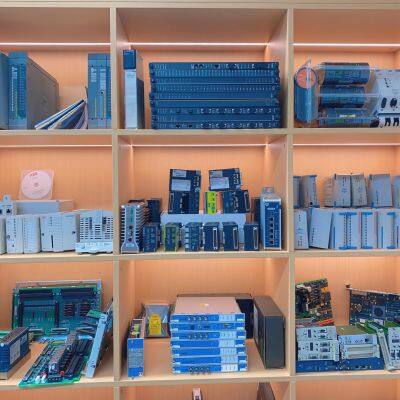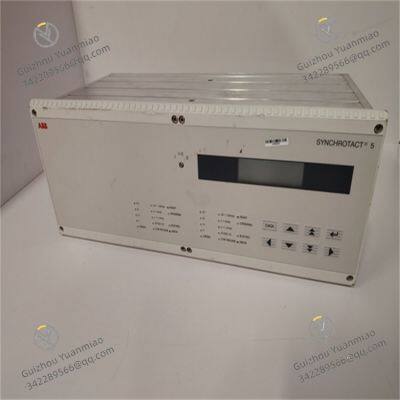Product Description
I. Overview
ABB 3BHB006716R0277 is a high-precision synchronous control module. Its core positioning is to solve the synchronous operation control challenges of multiple pieces of equipment (such as generators, motors, and transmission mechanisms) in industries including electric power, metallurgy, rail transit, and heavy manufacturing. It provides a stable and reliable control solution for the "multi-equipment collaborative operation and precise phase/speed matching" of complex industrial systems.
Integrating high-precision synchronous detection, dynamic coordination algorithms, and multi-protocol communication functions, it enables real-time monitoring and synchronous adjustment of key parameters (e.g., speed, phase, and position) of multiple devices. This effectively addresses issues in industrial scenarios caused by equipment asynchrony, such as reduced efficiency, mechanical wear, and product quality fluctuations. It is suitable for applications including generator grid-connection synchronous control in power plants, multi-rolling mill collaborative transmission in metallurgical plants, multi-motor synchronization in rail transit traction systems, and multi-axis linkage in heavy machine tools—ensuring the stability, efficiency, and safety of the overall industrial system operation.
This module adopts a standard 3U industrial board design (dimensions approximately 220mm×160mm×45mm), which is compatible with ABB standard cabinet slots. It realizes low-latency data interaction with the system main controller via a high-speed backplane bus (transmission rate: 50MB/s). The housing is made of reinforced flame-retardant plastic (UL94 V-0 grade) with a built-in heat sink, improving heat dissipation efficiency by 25% compared to traditional designs and adapting to high-load operation scenarios. It operates within a temperature range of -25℃~70℃ and a relative humidity of 5%~95% (non-condensing), enabling it to withstand complex environments such as high temperatures in power plants and high dust levels in metallurgical workshops.
It supports full redundancy configuration (power redundancy, communication redundancy, and synchronous detection channel redundancy) with a Mean Time Between Failures (MTBF) of ≥200,000 hours, meeting the "long-cycle and high-reliability" operation requirements of industrial systems. Additionally, it is compatible with third-party standard equipment and supports modular expansion—input and output channels can be flexibly configured according to the number of synchronously controlled devices, adapting to synchronous control scenarios of different scales.

II. Technical Parameters
Electrical Parameters
2. Environmental and Reliability Parameters
3. Synchronous Control and Communication Parameters

III. Functional Features
1. High-Precision Multi-Equipment Synchronous Control
With high-precision synchronous detection and dynamic coordination as its core, 3BHB006716R0277 enables precise synchronous operation of multiple industrial devices:
Multi-Parameter Synchronous Detection and Regulation
It supports simultaneous access to synchronous signals (e.g., speed pulses, phase signals, position encoder signals) from 8 devices. Equipped with a 24-bit high-precision sampling chip, it achieves a speed measurement accuracy of ±0.001% FS, a phase measurement accuracy of ±0.1°, and a position measurement resolution of ±0.001mm (compatible with linear encoders). For example, in generator grid-connection control of power plants, the module simultaneously collects voltage phase and frequency signals from the generator to be connected to the grid and the power grid—with a frequency measurement accuracy of ±0.001Hz and a phase difference detection accuracy of ±0.1°—providing accurate data support for grid-connection synchronous regulation.
Through its built-in PID synchronous regulation algorithm, it outputs 4-20mA control signals to adjust the generator’s excitation current or speed based on the detected speed difference and phase difference. This enables rapid matching of the generator’s frequency and phase with the power grid, resulting in a grid-connection inrush current of ≤5% of the rated current—far lower than the industry standard (≤10%).
Dynamic Synchronous Coordination Algorithm
It integrates an adaptive synchronous coordination algorithm that can real-time adjust synchronous control parameters (proportional coefficient, integral time) according to equipment load changes (e.g., rolling load fluctuations of rolling mills) and external interference (e.g., power grid voltage fluctuations) without manual intervention. For instance, in multi-rolling mill collaborative transmission in metallurgical plants, if the load of one rolling mill increases (current rises from 800A to 1000A) due to changes in steel plate thickness, the module quickly adjusts the output torque and speed of other rolling mills via the algorithm. This ensures the speed synchronization deviation of multiple rolling mills is ≤0.01%, preventing steel plate stretching deformation or strip breakage.
It supports two control modes: "master-slave synchronization" and "peer-to-peer synchronization". In master-slave mode, one device (e.g., Rolling Mill No.1) serves as the reference, and other devices adjust accordingly; in peer-to-peer mode, multiple devices are coordinately regulated based on average parameters—adapting to synchronous requirements of different industrial scenarios.
Rapid Synchronous Response Capability
With a synchronous regulation response time of ≤10ms, it can handle sudden operating condition changes of equipment (e.g., sudden increase in motor load, power grid frequency fluctuations). For example, in rail transit traction systems, when a train starts or brakes, the module responds to speed changes of multiple traction motors within 10ms and adjusts the motors’ output torque. This ensures the speed synchronization deviation of the motors is ≤0.05%, preventing wheel-set slipping or wear and improving the safety and comfort of train operation.

2. Multiple Safety Protections and Fault Diagnosis
In response to the risk of "equipment asynchrony easily causing safety accidents" in industrial synchronous control scenarios, the module maximizes system safety through multiple protection and intelligent diagnosis designs:
Comprehensive Synchronous Fault Protection
It has built-in functions including over-limit protection for synchronous deviation, abnormal equipment shutdown protection, and signal loss protection:
Over-limit Protection for Synchronous Deviation: The threshold can be flexibly set according to equipment type (e.g., phase difference threshold for generator grid-connection ≤5°, speed difference threshold for rolling mills ≤0.1%). When a deviation exceeding the threshold is detected, it immediately outputs an alarm signal and triggers regulation; if the deviation exceeds the threshold for 100ms continuously, it cuts off the control output to prevent equipment damage. For example, in multi-axis linkage of heavy machine tools, if the position deviation of one axis exceeds 0.01mm and persists for 100ms, the module immediately stops the machine tool, avoiding workpiece processing scrap or machine tool collision.
Abnormal Equipment Shutdown Protection: It real-time monitors the operating status (e.g., motor current, temperature) of synchronized equipment. If one device shuts down due to a fault, the module quickly controls other devices to reduce speed or shut down, preventing mechanical transmission damage caused by asynchronous operation.
Signal Loss Protection: In case of loss of synchronous detection signals (e.g., encoder signals), it immediately activates backup signals (e.g., backup encoder, speed estimation value) to maintain basic synchronous control while outputting a fault alarm.
Intelligent Fault Diagnosis and Feedback
It integrates a high-precision fault diagnosis unit that can real-time monitor the status of the module’s internal circuits (e.g., synchronous detection chip, operation unit, communication interface), synchronous signal quality, and equipment operating parameters—achieving a diagnosis coverage rate of 99%.
Fault information is intuitively fed back via LED indicators (PWR: green for power, RUN: green for operation, ERR: red for fault, SYNC: yellow for synchronization). Meanwhile, detailed fault codes (e.g., "E01: Synchronous Deviation Over-limit", "E06: Encoder Signal Loss", "E12: Operation Unit Abnormality") are uploaded to the controller or upper computer via RS485/Profinet communication interfaces. Maintenance personnel can quickly locate problems using the fault codes, reducing troubleshooting time by 70%. For example, if the module detects loss of the generator grid-connection phase signal, it immediately triggers the ERR indicator to light up, uploads the fault code "E06: Encoder Signal Loss", and activates a backup phase detection signal to ensure uninterrupted grid-connection control.
Redundant Backup and Fault-Tolerant Operation
It supports dual-module redundant configuration (master-standby mode). If the master module fails, the standby module automatically switches to operation within 50ms, and synchronous control parameters are seamlessly inherited—ensuring uninterrupted synchronous operation of multiple devices. For example, in the generator grid-connection system of power plants, the dual-module redundant configuration avoids grid-connection delays caused by synchronous module faults, ensuring power supply stability.
It also supports synchronous detection channel redundancy (1:1 redundancy for key signal channels). If the main channel signal is abnormal, it automatically switches to the backup channel within ≤1ms, ensuring continuous and reliable synchronous detection data.
GE IS200AEADH1AAA Input/Output Grid Fork Board
Basler Electric DECS125-15-B1 Digital Excitation Controller
BENTLY NEVADA 3701/55 ADAPT Condition Monitor
GE L90-W03-HKH-F8L-H6P-L6C-N6C-S6C-U6L-W7G Multilin L90 protector
ABB PM863K01 3BSE088381R1 AC 800M processor unit Controller
ABB NGC8206 Natural Gas Chromatographs


Lam Research 810-068158-014 PCBA CIRCUIT BOARD
GE DS200TCDAH1BJE Mark V Digital I/O Board
ABB 086329-004 End Column Sensor Module
ABB 086370-001 Circuit Board
ABB 086339-501 Digital Input Module
ABB 086348-001 PC Board
ABB 086444-005 Measurement Process Board
ABB RMU610 2VAA008425R1 Repeater Mounting Unit
ABB CHBX01L 2VAA008574R1 Compact Bus Extender
ABB CHBX01R 2VAA008575R1 Compact Bus Extender
ABB UFC921A 3BHE024856P106 Communication Module
ABB PP886 3BSE092980R1 Operation Panel
 yezi
Hi there! Welcome to my shop. Let me know if you have any questions.
yezi
Hi there! Welcome to my shop. Let me know if you have any questions.




